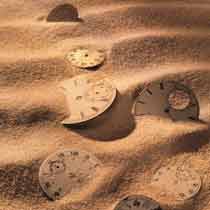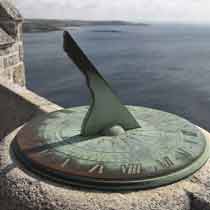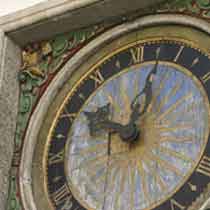HOST:

This is SCIENCE IN THE NEWS, in VOA Special English. I'm Steve Ember. This week our program is about a mystery as old as time. Bob Doughty and Sarah Long tell about the mystery of time.
(THEME)
VOICE ONE:
If you can read a clock, you can know the time of day. But no one knows what time itself is. We cannot see it. We cannot touch it. We cannot hear it. We know it only by the way we mark its passing.
For all our success in measuring the smallest parts of time, time remains one of the great mysteries of the universe.
VOICE TWO:
One way to think about time is to imagine a world without time. There could be no movement, because time and movement cannot be separated.
A world without time could exist only as long as there were no changes. For time and change are linked. We know that time has passed when something changes.
VOICE ONE:
In the real world -- the world with time -- changes never stop. Some changes happen only once in a while, like an eclipse of the moon. Others happen repeatedly, like the rising and setting of the sun. Humans always have noted natural events that repeat themselves. When people began to count such events, they began to measure time.
In early human history, the only changes that seemed to repeat themselves evenly were the movements of objects in the sky. The most easily seen result of these movements was the difference between light and darkness.
The sun rises in the eastern sky, producing light. It moves across the sky and sinks in the west, causing darkness. The appearance and disappearance of the sun was even and unfailing. The periods of light and darkness it created were the first accepted periods of time. We have named each period of light and darkness -- one day.
VOICE TWO:
People saw the sun rise higher in the sky during the summer than in winter. They counted the days that passed from the sun's highest position until it returned to that position. They counted 365 days. We now know that is the time Earth takes to move once around the sun. We call this period of time a year.
VOICE ONE:
Early humans also noted changes in the moon. As it moved across the night sky, they must have wondered. Why did it look different every night? Why did it disappear? Where did it go?
Even before they learned the answers to these questions, they developed a way to use the changing faces of the moon to tell time.
The moon was "full" when its face was bright and round. The early humans counted the number of times the sun appeared between full moons. They learned that this number always remained the same -- about 29 suns. Twenty-nine suns equaled one moon. We now know this period of time as one month.
(MUSIC)
VOICE TWO:
Early humans hunted animals and gathered wild plants. They moved in groups or tribes from place to place in search of food. Then, people learned to plant seeds and grow crops. They learned to use animals to help them work, and for food.
They found they no longer needed to move from one place to another to survive.
As hunters, people did not need a way to measure time. As farmers, however, they had to plant crops in time to harvest them before winter. They had to know when the seasons would change. So, they developed calendars.
No one knows when the first calendar was developed. But it seems possible that it was based on moons, or lunar months.
When people started farming, the wise men of the tribes became very important. They studied the sky. They gathered enough information so they could know when the seasons would change. They announced when it was time to plant crops.
(MUSIC)
VOICE ONE:
The divisions of time we use today were developed in ancient Babylonia 4,000 years ago. Babylonian astronomers believed the sun moved around the Earth every 365 days. They divided the trip into 12 equal parts, or months. Each month was 30 days. Then, they divided each day into 24 equal parts, or hours. They divided each hour into 60 minutes, and each minute into 60 seconds.
VOICE TWO:

Humans have used many devices to measure time. The sundial was one of the earliest and simplest.
A sundial measures the movement of the sun across the sky each day. It has a stick or other object that rises above a flat surface. The stick, blocking sunlight, creates a shadow. As the sun moves, so does the shadow of the stick across the flat surface. Marks on the surface show the passing of hours, and perhaps, minutes.
The sundial works well only when the sun is shining. So, other ways were invented to measure the passing of time.
VOICE ONE:
One device is the hourglass. It uses a thin stream of falling sand to measure time. The hourglass is shaped like the number eight --- wide at the top and bottom, but very thin in the middle. In a true "hour" glass, it takes exactly one hour for all the sand to drop from the top to the bottom through a very small opening in the middle. When the hourglass is turned with the upside down, it begins to mark the passing of another hour.
By the 18th century, people had developed mechanical clocks and watches. And today, many of our clocks and watches are electronic.
VOICE TWO:

So, we have devices to mark the passing of time. But what time is it now? Clocks in different parts of the world do not show the same time at the same time. This is because time on Earth is set by the sun's position in the sky above.
We all have a 12 o'clock noon each day. Noon is the time the sun is highest in the sky. But when it is 12 o'clock noon where I am, it may be 10 o'clock at night where you are.
VOICE ONE:
As international communications and travel increased, it became clear that it would be necessary to establish a common time for all parts of the world.
In 1884, an international conference divided the world into 24 time areas, or zones. Each zone represents one hour. The astronomical observatory in Greenwich, England, was chosen as the starting point for the time zones. Twelve zones are west of Greenwich. Twelve are east.
The time at Greenwich -- as measured by the sun -- is called Universal Time. For many years it was called Greenwich Mean Time.
VOICE TWO:
Some scientists say time is governed by the movement of matter in our universe. They say time flows forward because the universe is expanding. Some say it will stop expanding some day and will begin to move in the opposite direction, to grow smaller. Some believe time will also begin to flow in the opposite direction -- from the future to the past. Can time move backward?
Most people have no trouble agreeing that time moves forward. We see people born and then grow old. We remember the past, but we do not know the future. We know a film is moving forward if it shows a glass falling off a table and breaking into many pieces. If the film were moving backward, the pieces would re-join to form a glass and jump back up onto the table. No one has ever seen this happen. Except in a film.
VOICE ONE:
Some scientists believe there is one reason why time only moves forward. It is a well-known scientific law -- the second law of thermodynamics. That law says disorder increases with time. In fact, there are more conditions of disorder than of order.
For example, there are many ways a glass can break into pieces. That is disorder. But there is only one way the broken pieces can be organized to make a glass. That is order. If time moved backward, the broken pieces could come together in a great many ways. Only one of these many ways, however, would re-form the glass. It is almost impossible to believe this would happen.
VOICE TWO:
Not all scientists believe time is governed by the second law of thermodynamics. They do not agree that time must always move forward. The debate will continue about the nature of time. And time will remain a mystery.
(THEME)
HOST:
Our program was written by Marilyn Christiano and read by Sarah Long and Bob Doughty. I'm Steve Ember. Listen again next week for Science in the News, in VOA Special English.
thermodynamics: physics that deals with the relationships and conversions between heat and other forms of energy 热力学
Related stories:
Study shows loneliness can be infectious
In Egypt, King Tut's tomb getting a makeover
How you look in pictures tells a lot about you
A serious study looks at laughter worldwide
(来源:VOA 编辑:陈丹妮)